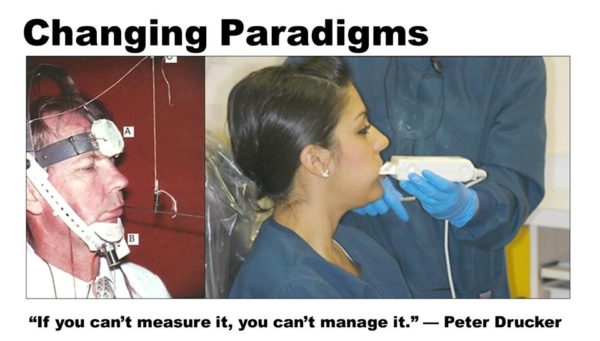While the original gnathic replicator took hours to assemble and calibrate in order to accurately collect jaw movement and occlusal pressure data, most of this information can now be quickly recorded by the T-Scan and instantly displayed on a computer screen for occlusal analysis. Force distribution scans corroborate the information recorded with complementary technologies such as EMG, JVA, digital radiology and digital photography. Combining the use of digital technologies creates new paradigms which connect master teachings of the past to Digital Occlusion™, our new reality.
The gnathic replicator measured force by recording amplitude of vibration transmitted to a receiver at the chin via teeth, joints, and muscle pathways. Force was measured in pounds using a sound transmission method. The vibration was transmitted to a receiver at the chin via teeth, joints, and muscle pathways.
Dr. William Maness from Tufts and a group of engineers from MIT introduced the concept of computerized occlusal analysis in April 1987. T-Scan technology revolutionized the measurement of occlusal contacts by introducing electronic evidence recorded with a sensor designed to collect occlusal force data. It recorded relative pressure from 0% to 100%, stop contact, and from 100% to no contact every one hundredth (0.01) of a second.
A decade ago, Dr. Dawson recognized the shifting paradigm occurring in dental technology. He enlisted master technician Lee Culp to write chapter 46 of his “Functional Occlusion” book entitled “The Technological Future for Occlusal Restoration.” In 2007, Pete wrote, “The paradigm shift has already occurred” but he also advises, “While new technology and computerization can make procedures more efficient, less labor-intensive, and more consistent, they will not replace education, practical experience, and clinical/technical judgment.”
The master teachers brought us to today. It is our common responsibility to advance the science from now on. Are you up to the challenge?
